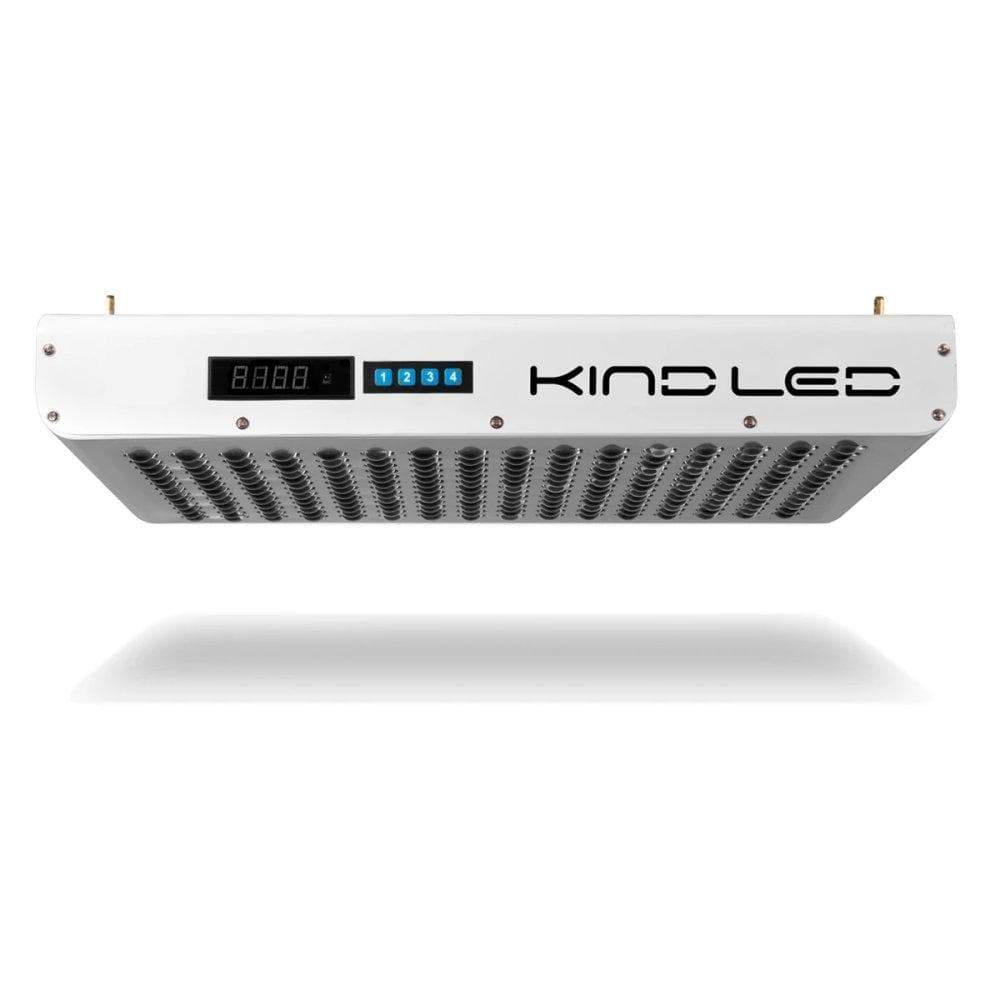No plant can live a long, healthy life without plenty of light—especially marijuana.
When you consider most cannabis varieties evolved in reliably temperate areas, it’s no surprise this plant loves to soak up a ton of sun.
If you’re going to grow ganja indoors, you must find a way to bring some of that full-spectrum goodness into your grow tent.
Thankfully, many exceptional manufacturers are putting out phenomenal grow light units. As long as you have a good sense of what you’re looking for, we bet one of the light models below will “brighten” your grow space.
LED vs. HID – What’s The Better Choice?
Today, a big debate in the cannabis community is whether LED lights are superior to the traditional high-intensity discharge lights (HID).
Although there’s still controversy over this issue, most contemporary cultivators prefer LED panels because they are easier to operate, take up less space, and don’t draw as much power. And, to sweeten the deal, many LED models are cheaper than HID units.

A significant drawback of using HIDs is they give off a tremendous amount of heat. Indeed, these blazing bulbs require a cooling mechanism to keep the temperature in your grow tent at a manageable level.
Also, there’s the added annoyance of swapping out your HID bulbs from metal halide to high-pressure sodium at different stages of growth.
Despite all of these drawbacks, HIDs still have a dedicated following in the cannabis community. Some users swear these lights produce marijuana plants with superior terpene and cannabinoid profiles.
In most cases, at-home cultivators will have an easier time fitting LED grow lights into their grow tent. New home-growers should look exclusively at LED models as they tend to be more cost-effective and user-friendly.
Although we’re going to focus on LED lights in this post, please keep in mind Everything But The Plant offers many HID bulbs. Please don’t hesitate to reach out to our Customer Care division if you have questions about our products.
What To Consider Before Buying A Grow Light?
Before purchasing your first grow light, please make sure you take accurate measurements of your grow space. Obviously, it’d be a big bummer to buy a brand-new light only to discover it won’t fit in your tent! You also want to ensure your grow light covers your desired number of plants.
Another critical feature to research is whether your LED unit is “full-spectrum.”
While no grow light could rival natural sunlight, you should strive to supply your buds with the broadest range of lightwaves. In general, the more wavelengths your grow light gives off, the better off your plants will be.
The Five Best Grow Lights of 2020
While you’re reviewing different lights, please also pay careful attention to the actual “power draw” your grow light will take.
This info will give you a good read on how much you’ll have to put aside for energy once you turn your grow light on.
Oh yeah, and please verify your tent’s top bars can support your grow light’s official weight. We think you could appreciate just how dangerous it is to hang a heavy grow light on flimsy frames!

1. KIND LED K5 XL1000 WiFi Grow Light
Although every name in the KIND LED portfolio is highly regarded, the K5 XL1000 stands apart due to its innovative WiFi connectivity. Customers who use this 1000W grow light gain access to the “KIND Command Center” app. With this novel technology, you could quickly set your preferred lighting schedule with a few clicks on your laptop. The KIND K5 also has an LED screen on the side to help you verify everything is going according to plan.
In addition to the app connectivity, the KIND K5 XL1000 has its signature 12-band full-spectrum display with 320 diodes. This unit weighs about 36 pounds and has an average lifespan of over 50,000 hours.
While the KIND K5 certainly isn’t cheap, it’s ideal for cultivators who want maximum control over their grow space.
If you’d like a more in-depth review of the KIND brand, please be sure to read through this previous post. You could also find out more details on this light model on Everything But The Plant.
2. PhytoMAX-2 1000 LED Grow Lights
Like KIND, Black Dog LED is a premium brand with a lot of star power in the indoor gardening community. One of this company’s top products is its 1000 LED grow light called the PhytoMAX-2.
With a reported 1602 μMol/s of total photon flux, this LED light is reputed to be one of the strongest in the industry. Black Dog LED also claims it worked for years developing its proprietary “Phyto-Genesis Spectrum,” which purportedly creates perfect lighting conditions for cannabinoid and terpene production.
On top of this unit’s strength, the PhytoMAX-2 1000 can cover a lot of space. Indeed, Black Dog LED claims the PhytoMAX-2 1000 covers a staggering 6.5’ x 6.5’ during flowering.
Unfortunately, you are going to pay a hefty fee if you want to harness the Phyto-MAX-2’s superior power. The PhytoMAX-2 1000 is often listed as one of the priciest grow lights on the market. Still, anyone looking for maximum area coverage and light power should research PhytoMAX-2’s specs.
3. Mars TS 1000 Quantum Board LED Grow Light
Mars LED is as well-known in cannabis grow circles as KIND and PhytoMAX, but not for the same reason. Don’t get us wrong, Mars puts out many great LED lights; but when most people hear this name, they instantly think: “affordability.”
When you see the price of the Mars TS 1000 compared with a KIND K5 XL1000, you most likely will think something fishy is going on. How could a company offer a 1000W grow light at such ridiculously low prices? Although it seems unreal, the MARS TS 1000 provides a powerful full-spectrum LED light for rock-bottom prices.
Of course, many design features help keep the Mars TS 1000 at a budget price point. First off, all of these lights have the “made in China” label. Next, Mars doesn’t cover its diodes. The side paneling on the Mars TS 1000 also doesn’t concentrate light as good as premier models. The suggested coverage area of the Mars TS 1000 is also somewhat small at 3’ x 3’ for vegetation and 2’ x 2’ for flowering.
However, it’s hard to be too picky considering the Mars TS 1000’s affordable price. This is the perfect model for new at-home cultivators who want a powerful LED unit without breaking the bank. It may not have all the frills you’ll find in other brands, but it works fine in a professional grow tent.
Would you like to learn more about the MARS TS 1000? If so, be sure to follow this page on Everything But The Plant.
4. MINT LED 600 LED Panel
Although MINT hasn’t “ceminted” a name in the indoor grow space, it’s definitely worth a peek if you’re a new home-grower. The MINT LED 600 is a fine full-spectrum panel that offers users three settings for different growth stages. This particular model has 210 diodes that give off both IR and UV to simulate sunlight. As a bonus, although this LED puts out 600W of energy, it will only take 420W.
The dimensions of the MINT 600 are 20” x 14” x 6”, which makes it ideal for small to mid-sized growing areas. Plus, this unit is easy to move at only 16 lbs.
Oh yeah, in case you were wondering, the MINT grow light does have a minty green color scheme! Don’t believe us? Check out the MINT LED 600 on this link.
5. Solarxtreme 1000 LED Grow Light
Many people in the growing community are getting excited about “chip on board” technology. In a nutshell, “COBs” string multiple LEDs together, which creates a more powerful full-spectrum light with less energy.
Many cultivators who use COB lights say they reduce energy output and make lighting units, well, “lighter” (in both senses of the word).
Unfortunately, since COB is such a new technology, it’s often a costly option. One exception to this rule is the SolarXtreme 1000.
While this unit isn’t “cheap,” it’s very affordable considering the high-quality of its proprietary COB panels. This 18” x 18” x 4” unit also has a respectable PPFD of 500 μMol/s at 38” and 800 μMol/s at 28”.
One potential drawback of the SolarXtreme 1000 is that it draws extra power than other LED models. While giving off 1000W of power, SolarXtreme 1000 will take about 800W.
Still, there are many positive features surrounding this exciting COB model. If you’d like to learn more about the SolarXtreme 1000, be sure to click this link on Everything But The Plant.
Enjoy Brighter Bulbs (And Buds!) With A Professional Grow Tent
Choosing a great grow light is crucial for cannabis growing, but please don’t forget to invest in a high-quality grow tent. It doesn’t matter how intense your grow light is; you’re not enjoying the max LED power if there’s no interior Mylar coating. Besides intensifying your LED unit’s luminosity, grow tents provide remarkable insulation and temperature control. Even in the dead of winter, you could keep your buds nice and warm in your well-threaded grow tent.
If you’re interested in looking for a professional grow tent, we encourage you to read through this post on the best small grow tents. You could also take a look at our full grow tent portfolio on this webpage.





















